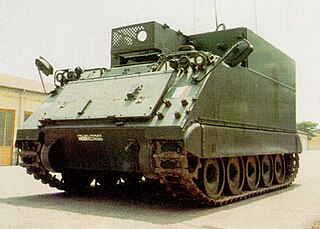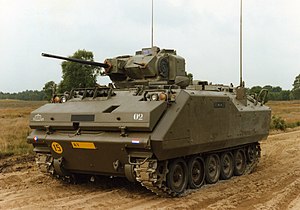
An infantry fighting vehicle (IFV), also known as a mechanized infantry combat vehicle (MICV), is a type of armoured fighting vehicle used to carry infantry into battle and provide direct-fire support. The 1990 Treaty on Conventional Armed Forces in Europe defines an infantry fighting vehicle as "an armoured combat vehicle which is designed and equipped primarily to transport a combat infantry squad, and which is armed with an integral or organic cannon of at least 20 millimeters calibre and sometimes an antitank missile launcher". IFVs often serve both as the principal weapons system and as the mode of transport for a mechanized infantry unit.

The Bradley Fighting Vehicle (BFV) is a tracked armored fighting vehicle of the United States developed by FMC Corporation and now manufactured by BAE Systems Land & Armaments, formerly United Defense. It is named for U.S. General Omar Bradley.

The M113 is a fully tracked armored personnel carrier (APC) that was developed and produced by the FMC Corporation. The M113 was sent to United States Army Europe in 1961 to replace the mechanized infantry's M59 APCs. The M113 was first used in combat in April 1962 after the United States provided the South Vietnamese army (ARVN) with heavy weaponry such as the M113, under the Military Assistance Command, Vietnam (MACV) program. Eventually, the M113 was the most widely used armored vehicle of the U.S. Army in the Vietnam War and was used to break through heavy thickets in the midst of the jungle to attack and overrun enemy positions. It was largely known as an "APC" or an "ACAV" by the allied forces.

The Royal Marechaussee also translated as the Royal Military Constabulary, is the national gendarmerie force of the Netherlands, performing military and civilian police duties. It is also one of the two national police forces in the Netherlands, alongside the National Police Corps, and is one of the four branches of the Netherlands Armed Forces.

The Bionix (BX) is a family of tracked Singaporean armoured fighting vehicles developed by ST Kinetics. Intended to augment the Singapore Army's aging M113 armoured personnel carriers, it is the first indigenous armoured vehicle to be developed in Southeast Asia. The Bionix has been operational with the Singapore Armed Forces (SAF) since 1999 in a wide variety of adaptations including the Bionix II, Bionix 25 and Bionix 40/50 variants.

The Fennek, named after the fennec, or LGS Fennek, with LGS being short for Leichter Gepanzerter Spähwagen in German, is a four-wheeled armed reconnaissance vehicle produced by the German company Krauss-Maffei Wegmann and Dutch Defence Vehicle Systems. The Turkish company FNSS Defence Systems acquired the right for licence production in 2004. It was developed for both the German Army and Royal Netherlands Army to replace their current vehicles.

The M113½ Command and Reconnaissance Vehicle is a United States-built tracked reconnaissance armoured fighting vehicle, which was originally employed by the armed forces of the Netherlands and Canada and later Bahrain and Chile. Former Dutch vehicles were exported in the 1990s to Bahrain and Chile after being retired from service.

The AIFV is a US tracked light armored vehicle that serves as an infantry fighting vehicle (IFV) in the armies of several countries. It is a development of the M113A1 armored personnel carrier.
A huge number of M113 Armored Personnel Carrier variants have been created, ranging from infantry carriers to nuclear missile carriers. The M113 armored personnel carrier has become one of the most prolific armored vehicles of the second half of the 20th century, and continues to serve with armies around the world in many roles.

The M901 ITV is an American armored vehicle introduced into service in 1979, and designed to carry a dual M220 TOW launcher. It is based on the M113 Armored Personnel Carrier chassis. The M901 ITV is no longer in service with the United States Army, its primary user.
MICV-65, short for Mechanized Infantry Combat Vehicle, 1965, was a US Army project that studied a number of armored fighting vehicles that would replace the M113 and M114 as well as take on a variety of new roles. A number of designs were studied as part of the MICV project, but none of them entered service for a variety of reasons. Nevertheless, experience gained in the MICV project eventually led to the M2 Bradley, which incorporates many of the MICV concepts.
The Egyptian Infantry Fighting Vehicle (EIFV), also known as Infantry Fighting Vehicle Light (IFVL), is an Egyptian modification of the M113. It is a hybrid, based on an enlarged M113 chassis equipped with the complete two-man power-operated turret of the M2 Bradley IFV. The EIFV never entered production for Egyptian Army.

The First Division "7 December" was a division of the Royal Netherlands Army, active from at least 1946 to 2004. It was sent to Indonesia in 1946 to restore "peace, order and security" after the proclamation of Indonesian Independence in 1945.
FNSS Savunma Sistemleri A.Ş. is a Turkish defense manufacturer founded in 1988. It is owned 51% by Nurol Holding of Turkey and 49% by British–American firm BAE Systems Inc., and operates facilities located in Gölbaşı, Ankara.
The Northern Army Group (NORTHAG) was a NATO military formation comprising five Army Corps from five NATO member nations. During the Cold War NORTHAG was NATO's forward defence in the Northern half of the Federal Republic of Germany (FRG). The Southern half of the Federal Republic of Germany was to be defended by the four Army Corps of NATO's Central Army Group (CENTAG). During wartime NORTHAG would command four frontline corps and one reserve corps. Air support was provided by Second Allied Tactical Air Force.

The Oerlikon KBA is a 25 mm (25×137mm) autocannon, developed as a close range multipurpose weapon for the mechanised battlefield, originally made by Oerlikon and currently produced in Rheinmetall Italia S.p.A. facilities. It is a positively locked breech, gas and recoil operated cannon with a rotating bolt head and a dual-belt selective feed system taking a 25mm NATO cartridge. The rate of fire in burst mode is 600 rounds per minute but it can be adjusted electronically and reduced to single shot or a selectable range from 100 up to 200 rounds per minute.

The CM-21 is an armoured vehicle designed and manufactured by the Republic of China Armoured Vehicle Development Center, based on the United States' model M113 APC. The first prototype was manufactured in 1979, and the CM-21 officially entered service in 1982.

The Iveco MTV, military designation Manticore, is an infantry mobility vehicle designed and manufactered by IVECO Defence Vehicles for the Netherlands Armed Forces. The acquisition is part of the Joint Replacement Programme of Wheeled Vehicles of the Dutch Ministry of Defence, with deliveries planned from 2023 until 2026. In Dutch service, the Manticore will replace the ageing fleet of Mercedes-Benz 290GDs of the Royal Netherlands Army, the Land Rovers of the Netherlands Marine Corps and the remaining YPR-765s of the Royal Netherlands Air Force and Royal Netherlands Marechaussee. Deliveries are planned for the second half of 2023 and should be completed by 2026.

The M577 Command Post Carrier, also known as the M577 Command Post Vehicle or Armored Command Post Vehicle, is a variant of the M113 armored personnel carrier that was developed and produced by the Food Machinery and Chemical Corporation (FMC) to function on the battlefield as a mobile command post i.e. a tactical operations centre, usually at the battalion level. In U.S. military service its official designation is Carrier, Command Post, Light Tracked M577.

The PMMC G5 is a family of light tracked vehicles designed and manufactured by Flensburger Fahrzeugbau GmbH (FFG) of Germany. Although it is similar in appearance and design to the American M113, and the company manufacturers modernised versions of that vehicle, the PMMC G5 is an all-new ground-up design.





















